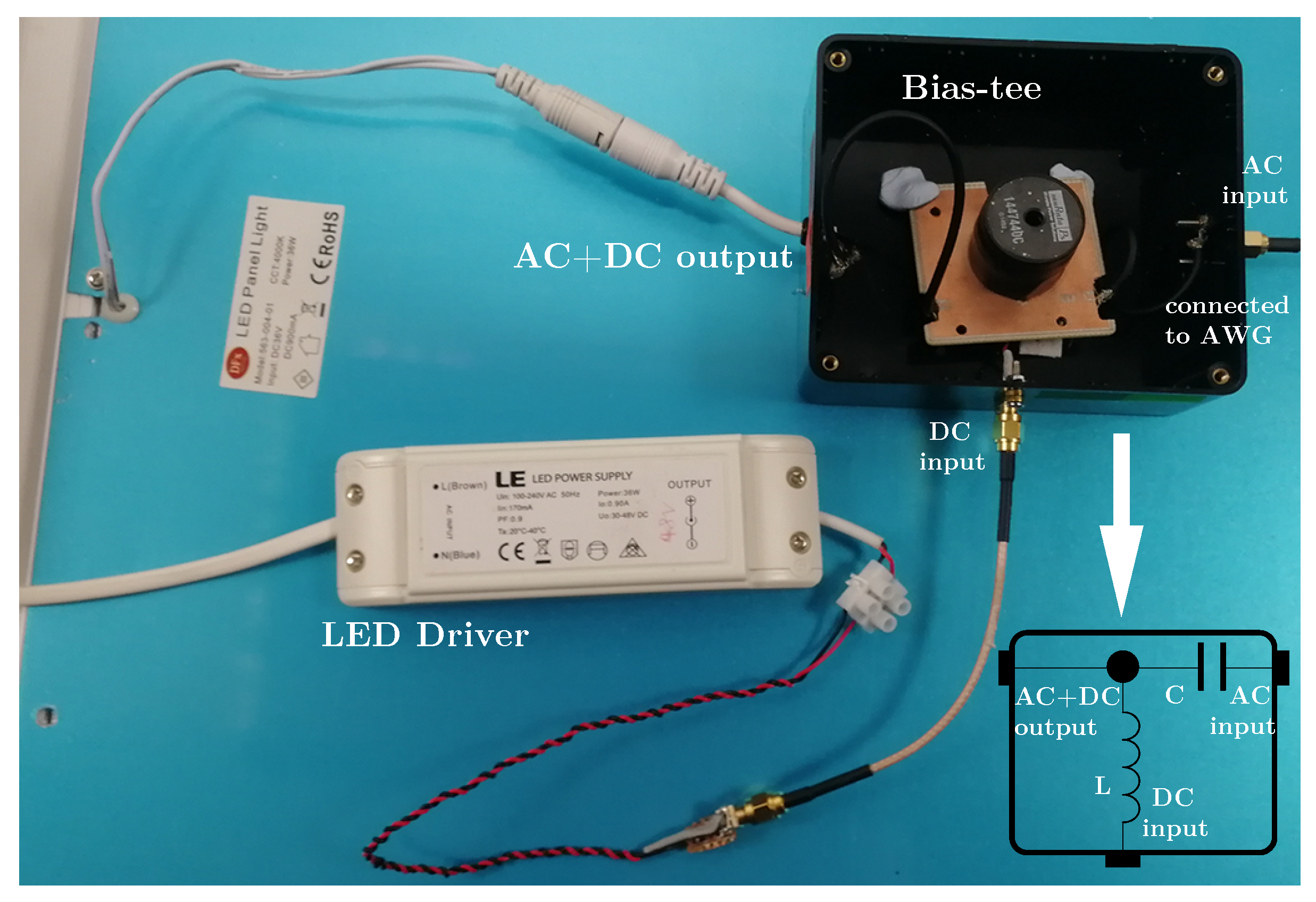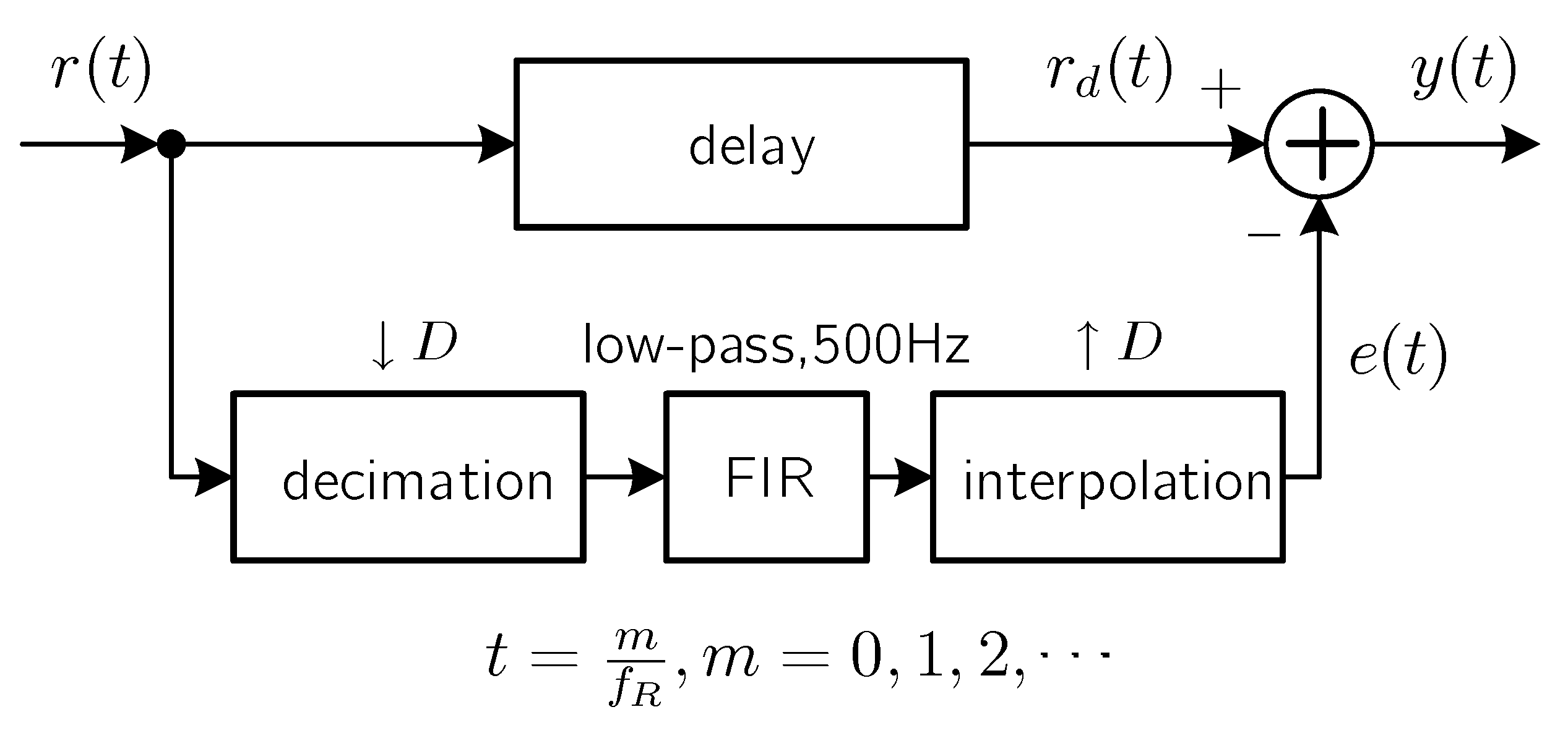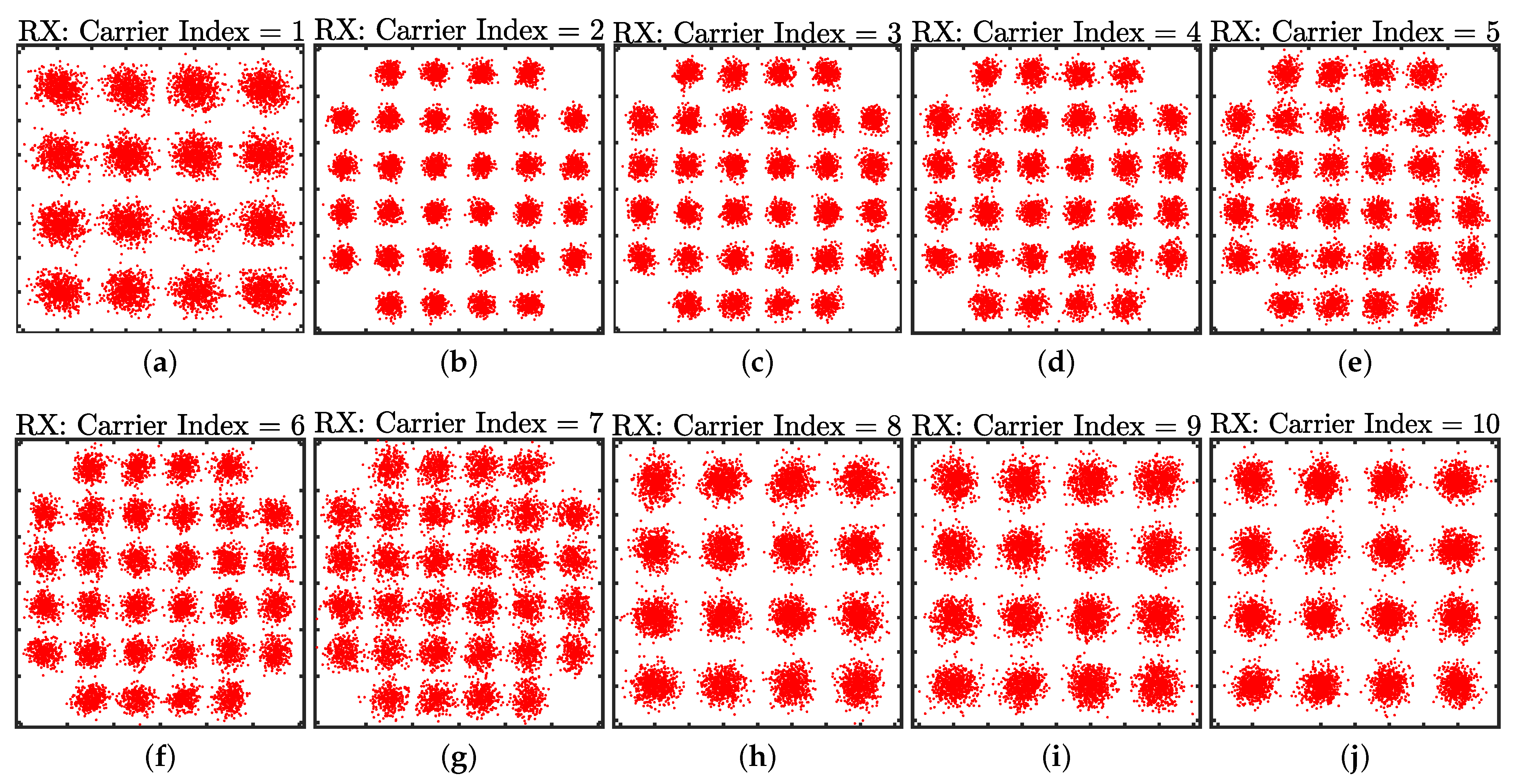A 40 Mb/s VLC System Reusing an Existing Large LED Panel in an Indoor Office Environment †
Abstract
:1. Introduction
2. Experimental Setup
2.1. The Light-Emitting Diode (LED) Panel
2.2. LED Panel Driver and Characteristics
2.3. Optical Receiver
2.4. MultiCAP for the Downlink Visible Light Communication
3. Challenges and Results
3.1. Flicker Issue and the Digital Signal Processing (DSP)-Based Solution
- A high-pass filter circuit can be inserted to filter out the low-frequency flicker if it is possible to modify the analogue frontend of the optical receiver.
- If it is not feasible to change the hardware, then DSP techniques can be used to remove the flicker by subtracting the low-frequency “envelope” from the received signal.
3.2. Results and Discussion
4. Conclusions
Supplementary Materials
Author Contributions
Funding
Institutional Review Board Statement
Informed Consent Statement
Data Availability Statement
Conflicts of Interest
References
- Ghassemlooy, Z.; Alves, L.N.; Zvanovec, S.; Khalighi, M.A. Visible Light Communications: Theory and Applications; CRC Press: Boca Raton, FL, USA, 2017. [Google Scholar]
- Uysal, M.; Capsoni, C.; Ghassemlooy, Z.; Boucouvalas, A.; Udvary, E. Optical Wireless Communications: An Emerging Technology; Springer: Berlin/Heidelberg, Germany, 2016. [Google Scholar]
- Rehman, S.U.; Ullah, S.; Chong, P.H.J.; Yongchareon, S.; Komosny, D. Visible Light Communication: A System Perspective—Overview and Challenges. Sensors 2019, 19, 1153. [Google Scholar] [CrossRef] [PubMed] [Green Version]
- Steigerwald, D.A.; Bhat, J.C.; Collins, D.; Fletcher, R.M.; Holcomb, M.O.; Ludowise, M.J.; Martin, P.S.; Rudaz, S.L. Illumination with solid state lighting technology. IEEE J. Sel. Top. Quantum Electron. 2002, 8, 310–320. [Google Scholar] [CrossRef]
- Haigh, P.A.; Ghassemlooy, Z.; Le Minh, H.; Rajbhandari, S.; Arca, F.; Tedde, S.F.; Hayden, O.; Papakonstantinou, I. Exploiting Equalization Techniques for Improving Data Rates in Organic Optoelectronic Devices for Visible Light Communications. J. Lightwave Technol. 2012, 30, 3081–3088. [Google Scholar] [CrossRef]
- Haigh, P.A.; Ghassemlooy, Z.; Rajbhandari, S.; Papakonstantinou, I. Visible light communications using organic light emitting diodes. IEEE Commun. Mag. 2013, 51, 148–154. [Google Scholar] [CrossRef]
- Nazari Chaleshtori, Z.; Ghassemlooy, Z.; Eldeeb, H.B.; Uysal, M.; Zvanovec, S. Utilization of an OLED-Based VLC System in Office, Corridor, and Semi-Open Corridor Environments. Sensors 2020, 20, 6869. [Google Scholar] [CrossRef] [PubMed]
- Chi, Y.C.; Hsieh, D.H.; Lin, C.Y.; Chen, H.Y.; Huang, C.Y.; He, J.H.; Ooi, B.; DenBaars, S.P.; Nakamura, S.; Kuo, H.C.; et al. Phosphorous Diffuser Diverged Blue Laser Diode for Indoor Lighting and Communication. Sci. Rep. 2015, 5, 18690. [Google Scholar] [CrossRef] [PubMed] [Green Version]
- Zafar, F.; Bakaul, M.; Parthiban, R. Laser-Diode-Based Visible Light Communication: Toward Gigabit Class Communication. IEEE Commun. Mag. 2017, 55, 144–151. [Google Scholar] [CrossRef]
- Liu, C.B.; Sadeghi, B.; Knightly, E.W. Enabling vehicular visible light communication (V2LC) networks. In Proceedings of the Eighth ACM International Workshop on Vehicular Inter-Networking, Las Vegas, NV, USA, September 2011; Association for Computing Machinery: New York, NY, USA, 2011; pp. 41–50. [Google Scholar]
- Marabissi, D.; Mucchi, L.; Caputo, S.; Nizzi, F.; Pecorella, T.; Fantacci, R.; Nawaz, T.; Seminara, M.; Catani, J. Experimental Measurements of a Joint 5G-VLC Communication for Future Vehicular Networks. J. Sens. Actuator Netw. 2020, 9, 32. [Google Scholar] [CrossRef]
- Caputo, S.; Mucchi, L.; Cataliotti, F.; Seminara, M.; Nawaz, T.; Catani, J. Measurement-based VLC channel characterization for I2V communications in a real urban scenario. Veh. Commun. 2020, 100305. [Google Scholar] [CrossRef]
- Nawaz, T.; Seminara, M.; Caputo, S.; Mucchi, L.; Catani, J. Low-Latency VLC System with Fresnel Receiver for I2V ITS Applications. J. Sens. Actuator Netw. 2020, 9, 35. [Google Scholar] [CrossRef]
- Khan, L.U. Visible light communication: Applications, architecture, standardization and research challenges. Digit. Commun. Netw. 2017, 3, 78–88. [Google Scholar] [CrossRef] [Green Version]
- Jungnickel, V.; Hinrichs, M.; Bober, K.L.; Kottke, C.; Corici, A.A.; Emmelmann, M.; Rufo, J.; Bök, P.; Behnke, D.; Riege, M.; et al. Enhance Lighting for the Internet of Things. In Proceedings of the Global LIFI Congress (GLC), Paris, France, 12–13 June 2019. [Google Scholar]
- Béchadergue, B.; Azoulay, B. An Industrial View on LiFi Challenges and Future. In Proceedings of the 12th International Symposium on Communication Systems, Networks and Digital Signal Processing (CSNDSP), Porto, Portugal, 20–22 July 2020; pp. 1–6. [Google Scholar]
- Haas, H.; Yin, L.; Wang, Y.; Chen, C. What is LiFi? J. Lightwave Technol. 2016, 34, 1533–1544. [Google Scholar] [CrossRef]
- ITU-T. G.9991: High-Speed Indoor Visible Light Communication Transceiver—System Architecture, Physical Layer and Data Link Layer Specification; ITU-T: Geneva, Switzerland, 2019. [Google Scholar]
- Oksman, V.; Galli, S.G. hn: The new ITU-T home networking standard. IEEE Commun. Mag. 2009, 47, 138–145. [Google Scholar] [CrossRef]
- ITU-T. G.9961: Unified High-Speed Wireline-Based Home Networking Transceivers—Data Link Layer Specification; ITU-T: Geneva, Switzerland, 2018. [Google Scholar]
- Sturniolo, A.; Cossu, G.; Messa, A.; Ciaramella, E. Ethernet over commercial lighting by a Visible Light Communication. In Proceedings of the 2018 Global LIFI Congress (GLC), Paris, France, 8–9 February 2018; pp. 1–4. [Google Scholar]
- Chvojka, P.; Burton, A.; Pesek, P.; Li, X.; Ghassemlooy, Z.; Zvanovec, S.; Anthony Haigh, P. Visible light communications: Increasing data rates with polarization division multiplexing. Opt. Lett. 2020, 45, 2977–2980. [Google Scholar] [CrossRef] [PubMed]
- Hu, F.; Li, G.; Zou, P.; Hu, J.; Chen, S.; Liu, Q.; Zhang, J.; Jiang, F.; Wang, S.; Chi, N. 20.09-Gbit/s Underwater WDM-VLC Transmission based on a Single Si/GaAs-Substrate Multichromatic LED Array Chip. In Proceedings of the Optical Fiber Communications Conference and Exhibition (OFC), San Diego, CA, USA, 8–12 March 2020; pp. 1–3. [Google Scholar]
- Bian, R.; Tavakkolnia, I.; Haas, H. 15.73 Gb/s Visible Light Communication With Off-the-Shelf LEDs. J. Lightwave Technol. 2019, 37, 2418–2424. [Google Scholar] [CrossRef] [Green Version]
- Burton, A.; Bentley, E.; Minh, H.L.; Ghassemlooy, Z.; Aslam, N.; Liaw, S.K. Experimental demonstration of a 10BASE-T Ethernet visible light communications system using white phosphor light-emitting diodes. IET Circuits Devices Syst. 2014, 8, 322–330. [Google Scholar] [CrossRef]
- Sung, J.Y.; Chow, C.W.; Yeh, C.H. Is blue optical filter necessary in high speed phosphor-based white light LED visible light communications? Opt. Express 2014, 22, 20646–20651. [Google Scholar] [CrossRef] [PubMed]
- Li, H.; Chen, X.; Guo, J.; Chen, H. A 550 Mbit/s real-time visible light communication system based on phosphorescent white light LED for practical high-speed low-complexity application. Opt. Express 2014, 22, 27203–27213. [Google Scholar] [CrossRef] [PubMed] [Green Version]
- Huang, X.; Wang, Z.; Shi, J.; Wang, Y.; Chi, N. 1.6 Gbit/s phosphorescent white LED based VLC transmission using a cascaded pre-equalization circuit and a differential outputs PIN receiver. Opt. Express 2015, 23, 22034–22042. [Google Scholar] [CrossRef]
- Li, X.; Ghassemlooy, Z.; Zvanovec, S.; Jimenezz, R.P.; Haigh, P. Should Analogue Pre-equalisers be Avoided in VLC Systems? IEEE Photonics J. 2020, 12, 1–14. [Google Scholar] [CrossRef]
- Haigh, P.A.; Darwazeh, I. Real-Time Experimental Demonstration of Multi-band CAP Modulation in a VLC System with Off-the-Shelf LEDs. In Proceedings of the IEEE INFOCOM 2019—IEEE Conference on Computer Communications Workshops (INFOCOM WKSHPS), Paris, France, 29 April–2 May 2019; pp. 1001–1002. [Google Scholar] [CrossRef] [Green Version]
- Haigh, P.A.; Burton, A.; Werfli, K.; Minh, H.L.; Bentley, E.; Chvojka, P.; Popoola, W.O.; Papakonstantinou, I.; Zvanovec, S. A Multi-CAP Visible-Light Communications System With 4.85-b/s/Hz Spectral Efficiency. IEEE J. Sel. Areas Commun. 2015, 33, 1771–1779. [Google Scholar] [CrossRef] [Green Version]
- Haigh, P.A.; Le, S.T.; Zvanovec, S.; Ghassemlooy, Z.; Luo, P.; Xu, T.; Chvojka, P.; Kanesan, T.; Giacoumidis, E.; Canyelles-Pericas, P.; et al. Multi-band carrier-less amplitude and phase modulation for bandlimited visible light communications systems. IEEE Wirel. Commun. 2015, 22, 46–53. [Google Scholar] [CrossRef]
- Wu, F.M.; Lin, C.T.; Wei, C.C.; Chen, C.W.; Chen, Z.Y.; Huang, H.T.; Chi, S. Performance Comparison of OFDM Signal and CAP Signal Over High Capacity RGB-LED-Based WDM Visible Light Communication. IEEE Photonics J. 2013, 5, 7901507. [Google Scholar] [CrossRef]
- Deng, X.; Arulandu, K.; Wu, Y.; Zhou, G.; Linnartz, J.M.G. Performance Analysis for Joint Illumination and Visible Light Communication Using Buck Driver. IEEE Trans. Commun. 2018, 66, 2065–2078. [Google Scholar] [CrossRef]
- Gao, Y.; Li, L.; Mok, P.K.T. An AC Input Inductor-Less LED Driver for Efficient Lighting and Visible Light Communication. IEEE J. Solid-State Circuits 2018, 53, 2343–2355. [Google Scholar] [CrossRef]
- Deng, X.; Arulandu, K.; Wu, Y.; Mardanikorani, S.; Zhou, G.; Linnartz, J.M.G. Modeling and Analysis of Transmitter Performance in Visible Light Communications. IEEE Trans. Veh. Technol. 2019, 68, 2316–2331. [Google Scholar] [CrossRef]
- Li, X.; Ghassemlooy, Z.; Zvanovec, S.; Haigh, P.A. Experimental Demonstration of a 40 Mb/s VLC System Using a Large Off-the-Shelf LED Panel. In Proceedings of the 2020 12th International Symposium on Communication Systems, Networks and Digital Signal Processing (CSNDSP), Porto, Portugal, 20–22 July 2020; pp. 1–5. [Google Scholar] [CrossRef]
- Li, X.; Ghassemlooy, Z.; Zvanovec, S.; Zhang, M.; Burton, A. Equivalent Circuit Model of High Power LEDs for VLC Systems. In Proceedings of the 2nd West Asian Colloquium on Optical Wireless Communications (WACOWC), Tehran, Iran, 27–28 April 2019; pp. 90–95. [Google Scholar]
- Mana, S.M.; Hellwig, P.; Hilt, J.; Berenguer, P.W.; Jungnickel, V. Experiments in Non-Line-of-Sight Li-Fi Channels. In Proceedings of the Global LIFI Congress (GLC), Paris, France, 12–13 June 2019; pp. 1–6. [Google Scholar]
- Eldeeb, H.B.; Uysal, M.; Mana, S.M.; Hellwig, P.; Hilt, J.; Jungnickel, V. Channel Modelling for Light Communications: Validation of Ray Tracing by Measurements. In Proceedings of the 2020 12th International Symposium on Communication Systems, Networks and Digital Signal Processing (CSNDSP), Porto, Portugal, 20–22 July 2020; pp. 1–6. [Google Scholar] [CrossRef]
- Olmedo, M.I.; Zuo, T.; Jensen, J.B.; Zhong, Q.; Xu, X.; Popov, S.; Monroy, I.T. Multiband Carrierless Amplitude Phase Modulation for High Capacity Optical Data Links. J. Lightwave Technol. 2014, 32, 798–804. [Google Scholar] [CrossRef] [Green Version]
- IEEE Power Electronics Society. IEEE Recommended Practices for Modulating Current in High-Brightness LEDs for Mitigating Health Risks to Viewers; IEEE: New York, NY, USA, 2015. [Google Scholar] [CrossRef]
- European Committee for Standardisation. Light and Lighting—Lighting of Work Places—Part 1: Indoor Work Places; BSI Standard Publication: Brussels, Belgium, 2011; Volume 12464, p. 10. [Google Scholar]














| Item | Value |
|---|---|
| LED panel model | DFx 563-004-01, 4000 K, 36 W |
| Lumens | 2700 lm |
| Luminous Efficiency | 75 lm/W |
| Voltage source | Keysight E3631A |
| Arbitrary waveform generator | Tektronix AFG3022 |
| Spectrum analyser | Keysight N9020A |
| Item | Value |
|---|---|
| Oscilloscope | Keysight DSO9254A |
| Arbitrary waveform generator | Tektronix AFG3022 |
| Arbitrary waveform generator output voltage | 10 Vpp (set at the 50 impedance) |
| Modulation bandwidth | = 10 MHz |
| MultiCAP carrier number | N = 10 |
| Carrier frequencies | 0.5 to 9.5 MHz with a step size of 1 MHz |
| Square-root raised cosine filter roll-off factor | |
| Square-root raised cosine filter length | 20 symbols |
| Baseband symbol rate | 869.57 kBaud |
| Bit-loading pattern | {4 5 5 5 5 5 5 4 4 4} |
| Aggregate data rate | Mb/s |
| Distance | Up to 2 m |
Publisher’s Note: MDPI stays neutral with regard to jurisdictional claims in published maps and institutional affiliations. |
© 2021 by the authors. Licensee MDPI, Basel, Switzerland. This article is an open access article distributed under the terms and conditions of the Creative Commons Attribution (CC BY) license (http://creativecommons.org/licenses/by/4.0/).
Share and Cite
Li, X.; Ghassemlooy, Z.; Zvánovec, S.; Haigh, P.A. A 40 Mb/s VLC System Reusing an Existing Large LED Panel in an Indoor Office Environment. Sensors 2021, 21, 1697. https://doi.org/10.3390/s21051697
Li X, Ghassemlooy Z, Zvánovec S, Haigh PA. A 40 Mb/s VLC System Reusing an Existing Large LED Panel in an Indoor Office Environment. Sensors. 2021; 21(5):1697. https://doi.org/10.3390/s21051697
Chicago/Turabian StyleLi, Xicong, Zabih Ghassemlooy, Stanislav Zvánovec, and Paul Anthony Haigh. 2021. "A 40 Mb/s VLC System Reusing an Existing Large LED Panel in an Indoor Office Environment" Sensors 21, no. 5: 1697. https://doi.org/10.3390/s21051697
APA StyleLi, X., Ghassemlooy, Z., Zvánovec, S., & Haigh, P. A. (2021). A 40 Mb/s VLC System Reusing an Existing Large LED Panel in an Indoor Office Environment. Sensors, 21(5), 1697. https://doi.org/10.3390/s21051697








